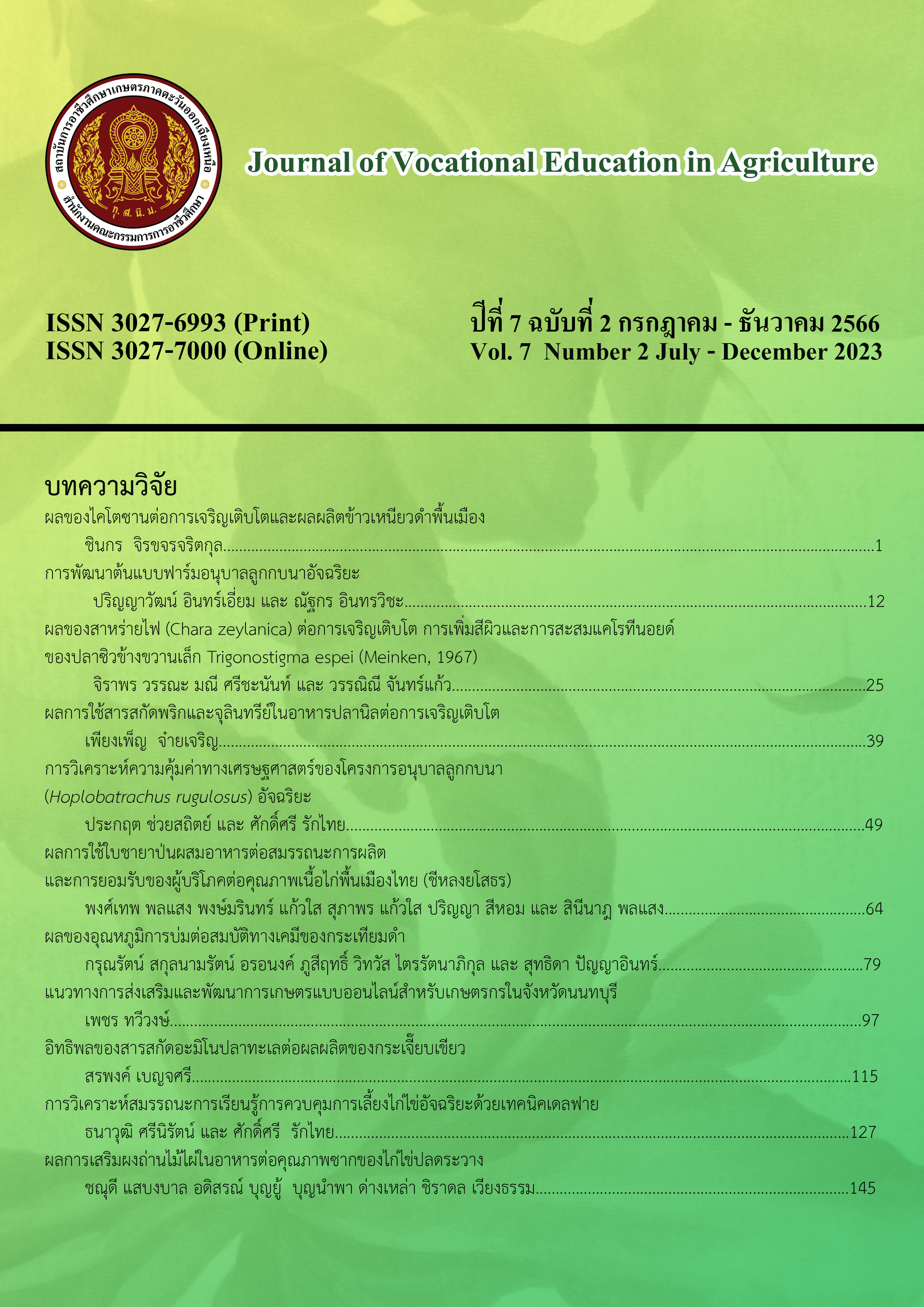การพัฒนาต้นแบบฟาร์มอนุบาลลูกกบนาอัจฉริยะ
Main Article Content
บทคัดย่อ
การศึกษานี้มีวัตถุประสงค์เพื่อออกแบบฟาร์มอนุบาลลูกกบนาอัจฉริยะ ดำเนินการวิจัยโดยแบ่งออกเป็น 3 ขึ้นตอนคือ 1) วิเคราะห์โครงสร้างสิ่งแวดล้อมธรรมชาติของการอนุบาลลูกกบนาแบบดั้งเดิมของแผนกวิชาประมง วิทยาลัยเกษตรและเทคโนโลยีนครศรีธรรมราชโดยออกแบบชุดอุปกรณ์บันทึกข้อมูลอุตุนิยมวิทยาระบบ IoT และวิเคราะห์ขนาดและทิศทางของความสัมพันธ์ระหว่างโครงสร้างสิ่งแวดล้อมธรรมชาติด้วยสัมประสิทธิ์สหสัมพันธ์ 2) ทดลองศึกษาปัจจัยที่มีอิทธิพลต่อการเจริญเติบโตของลูกกบนาโดยเปรียบเทียบอัตราการเจริญเติบโตและอัตราการรอดของลูกกบนาจากการอนุบาลลูกกบนาแบบดั้งเดิมและแบบไม่เปลี่ยนถ่ายน้ำ และ 3) ออกแบบระบบฟาร์มอนุบาลลูกกบนาอัจฉริยะโดยพิจารณาความสัมพันธ์ของโครงสร้างสิ่งแวดล้อมธรรมชาติ ข้อมูลคุณภาพน้ำและอัตราการเจริญเติบโตของลูกกบนา ผลการศึกษาพบว่าชุดอุปกรณ์บันทึกข้อมูลอุตุนิยมวิทยาระบบ IoTมีความแม่นยำตามหลักการของ Test Accuracy Ratio Level Standards ความเข้มแสงกับอุณหภูมิอากาศมีความสัมพันธ์ในทิศทางเดียวกัน (r=0.659) ความเข้มแสงกับความชื้นสัมพัทธ์มีความสัมพันธ์ในทิศทางตรงข้ามกัน (r=-0.627) ความเข้มแสงกับอุณหภูมิน้ำมีความสัมพันธ์ในทิศทางเดียวกัน (r=0.543) น้ำหนัก ความยาว และอัตราการรอด ของลูกกบนาจากการอนุบาลแบบดั้งเดิมมากกว่าการอนุบาลแบบไม่ถ่ายน้ำอย่างมีนัยสำคัญทางสถิติ (P<0.05) ผลของการศึกษาขั้นตอนที่ 1 และ 2 นำไปสู่ขั้นตอนที่ 3 คือการออกแบบฟาร์มอนุบาลลูกกบนาอัจฉริยะประกอบไปด้วยตาข่ายพรางแสงเพื่อควบคุมความเข้มแสงให้อยู่ในช่วง 900 Lux – 2,100 Lux อุปกรณ์ตรวจวัดความขุ่น ความเข้มแสง ความชื้นสัมพัทธ์และอุณหภูมิอากาศ โดยเมื่อระบบประมวลผลได้รับข้อมูลความชื้นสัมพัทธ์และหรืออุณหภูมิอากาศเกินระดับที่เหมาะสม ระบบจะพ่นละอองน้ำเพื่อควบคุมความชื้นสัมพัทธ์ และเมื่อระบบประมวลผลได้รับข้อมูลความขุ่นเกินระดับที่เหมาะสม ระบบจะเปลี่ยนถ่ายน้ำอัตโนมัติ
Article Details

อนุญาตภายใต้เงื่อนไข Creative Commons Attribution-NonCommercial-NoDerivatives 4.0 International License.
เนื้อหาและข้อมูลในบทความที่ลงตีพิมพ์ใน Journal of Vocational Education in Agriculture ถือเป็นข้อคิดเห็นและความรับผิดชอบของผู้เขียนบทความโดยตรง ซึ่งกองบรรณาธิการวารสารไม่จำเป็นต้องเห็นด้วยหรือร่วมรับผิดชอบใดๆ
บทความ ข้อมูล เนื้อหา ฯลฯ ที่ได้รับการตีพิมพ์ใน Journal of Vocational Education in Agriculture ถือเป็นลิขสิทธิ์ของJournal of Vocational Education in Agriculture หากบุคคลหรือหน่วยงานใดต้องการนำทั้งหมดหรือส่วนหนึ่งส่วนใดไปเผยแพร่ต่อหรือเพื่อกระทำการใดๆ จะต้องได้รับอนุญาตเป็นลายลักษณ์อักษรจาก Journal of Vocational Education in Agriculture ก่อนเท่านั้น
เอกสารอ้างอิง
American Museum of Natural History. (1998). Amphibian Species of the World 6.0, an Online Reference. Available from https://amphibiansoftheworld.amnh.org/. Accessed date: 20 August 2022.
Chewapreecha, J. (1991). Thai frogs go abroad. INVESTMENT PROMOTION JOURNAL, 2(1), 25-27. (in Thai)
Mualmuangsong, P., et al. (2014). Frog production and marketing in Muang distric, Loei province. Prawarun Agricultural Journal, 11(1), 65-72. (in Thai)
Department of Fisheries. (2020). Fishery production situation. Available from https:// www4.fisheries.go.th/local/index.php/main/viewactivities/1408/85332. Accessed date: 20 August 2022. (in Thai)
Thailand Board of Investment. (2020). Report on investment promotion conditions according to the investment promotion policy. Available from https://www.boi.go.th/index.php? page=statistics_condition_promotion&language=th. Accessed date: 20 August 2022. (in Thai)
National Economic and Social Development Plan No. 12 (2017-2021). (2015, 30 December). Royal Gazette. Vol. 133 Chapter 115 p.1. (in Thai)
NECTEC. (2018). Aqua Grow: An intelligent system for economic aquaculture. Available from https://www.nectec.or.th/innovation/innovation-hardware-electronics/aquagrow.html. Accessed date: 20 August 2022. (in Thai)
Nguyen, T. H. P. (2015). Effects of temperature and salinity on growth performance in cultured Tra catfish (Pangasianodon hypophthalmus) in Vietnam, (Doctoral dissertation, Queensland University of Technology).
Pinpirom, S. & Ganmanee, M. (2012). Study on water quality parameter in freshwater pond for management effective. In The 50th Kasetsart University Annual Conference (p. 562-573). 31 January – 1 Febuary, 2012, Bangkok, Thailand. (in Thai)
Jindaphan, N. & Lianyong, N. (2008). Effect of Temperature on Arowana (Scleropages formosus Muller and Schlegel, 1844) Larvae Development (Research reports). Bangkok: Department of Fisheries. (in Thai)
Uppanunchai, A., et al. (2017). The Optimal Nursing Temperature in Producing Rana rugulosa (Wiegmann, 1935). Journal Of Agricultural Research And Extension, 34(3), 31-40. (in Thai)
Woraserm, W., et al. (2019). Effect of Temperature on Reproductive Performance of Crossbred Frogs in the Winter Season. Prawarun Agricultural Journal, 16(2), 339 – 348. (in Thai)
Kanjanachatree, K. & Janekarn, V. (1996). The study of frog breeding: Food and Technique of feeding in different stages. (Research reports). Phuket: Prince of Songkla University. (in Thai)
Thip-uten, T., et al. (2019). Frog raising condition and diseases finding in Sakon Nakhon and Nakhon Phanom Provinces. Journal of Fisheries Technology Research, 13(1), 105-116. (in Thai)
Suttanarak, J. & Chusuwan, S. (2015). Calculation of volumetric calibration results. revised edition. Nonthaburi: Central Bureau of Weights & Measures. (in Thai)
La-ongsiriwong, N. (2019). Guide to water analysis for aquaculture and farm standard certification. Bangkok: Department of Fisheries. (in Thai)
Suraphan, T. & Tansangwrn, N. (2020). Industrial communication using Modbus protocol. Pathumthani: National Electronics and Computer Technology Center. (in Thai)
Treepolaugson, S. & Intaravicha, N. (2021). Effect ofLight Intensity on Nursing of Frog Tadpoles (Hoplobatrachus rugulosus). Journal of Vocational Institute of Agriculture, 5(1), 1-8. (in Thai)
Pradip na talang, T. & Rakthai, S. (2022). Natural Light Intensity Model of Surat Thani Province. Journal of Vocational Institute of Agriculture, 6(1), 23-38. (in Thai)
Patama, N. (2021). The development of Smart Farming Systems in Thailand. Bangkok: Office of the Secretariat of the Senate.
Pothong, T., et al. (2019). Development of Smart Farming Service System for Smart Farmer using FOSS4G and IoT. Naresuan Agriculture Journal, 16(2), 10-17. (in Thai)
Boyd, C. E. & Lichtkoppler, F. (1979). Water quality management for pond fish culture. Alabama: Auburn University.

